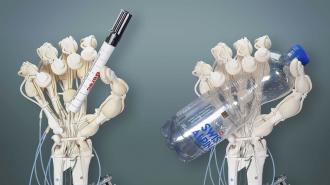By rapidly correcting for imperfections in 3D-printed layers, a new technique enables printing with a far wider range of materials. It allowed researchers to print out robots that mimic important biological functions, unlocking a universe of exciting new possibilities for bionic machines.
The challenge: Until recently, many of the most exciting possibilities presented by modern 3D printing have been held back by an unavoidable need for fast-curing polymers — basically, the plastic or other material that’s printed needs to set very quickly.
Then, as structures are built up layer by layer, printers need to scrape away any imperfections from the newly deposited polymer, before errors can build up in subsequent layers.
Existing 3D-printing techniques can’t print robots with the intricate structures and functions of living organisms.
Before this sculpting can happen, the polymer needs to harden as quickly as possible under ultraviolet light, preventing any uncured polymer from building up on the scraper. But because only a limited number of polymers can cure this quickly, this step has severely restricted the variety of materials available for 3D printing.
Ultimately, this setback has limited the complexity of 3D-printed structures, even in the latest generations of printers. In particular, it means that we haven’t yet printed out robots that can mimic the intricate structures and functions of living organisms, adapted to operate in their natural environments.
To mimic these behaviours, 3D printers must be able to combine multiple rigid structures using soft, flexible links – enabling robots that can perform tasks like bearing heavy loads and moving over uneven terrain. Yet without any way to iron out imperfections in slower-curing polymers – which exhibit a far greater variety of useful properties – this goal has remained out of reach so far.
The new technique: Rising to the challenge, a team of researchers at ETH Zurich in Switzerland have teamed up with Inkbit, a startup based in Medford, Massachusetts, which specialises in advanced 3D printing.
In a new study published in Nature, a team of researchers headed by Thomas Buchner at ETH Zurich’s Soft Robotics Lab present a technique they call “vision-controlled jetting.” After a new layer of polymer is deposited, it uses laser scanning to create a 3D map of its imperfections, accurate to within just tens of nanometres.
This process starts a feedback loop: when the printing nozzle next passes over the surface, it uses this map to smartly adjust the amount of polymer it deposits into the next layer – smoothing out any imperfections in real time, without need to scrape or sculpt. Afterwards, imperfections in the new layer are scanned, and the cycle repeats.
The robots: By eliminating any need for scraping, Buchner’s team were able to use more materials and print a wide array of complex robots, mimicking a variety of biological functions.
They included a robotic hand complete with bones, ligaments, and tendons, which could move each of its fingers independently. This dexterity allowed it to firmly grip objects including a pen, a set of keys, and a water bottle.
The researchers also created a walking robot, which used energy stored in compressed air to move its limbs, allowing it to navigate across bumpy, unpredictable surfaces. Even further, they designed a pump that could mimic the beating of the heart – using it to precisely control the flow of liquid between a series of tanks.
Plans for the future: Buchner’s team hope to explore the possibilities of vision-controlled jetting even further in their future research – with Inkbit now planning to offer it as a service to its customers. Already, the innovation looks set to pave the way for exciting new advances in robotics, perhaps bringing us a step closer to 3D-printed robots that can flawlessly mimic the function of our own bodies.
We’d love to hear from you! If you have a comment about this article or if you have a tip for a future Freethink story, please email us at tips@freethink.com.
